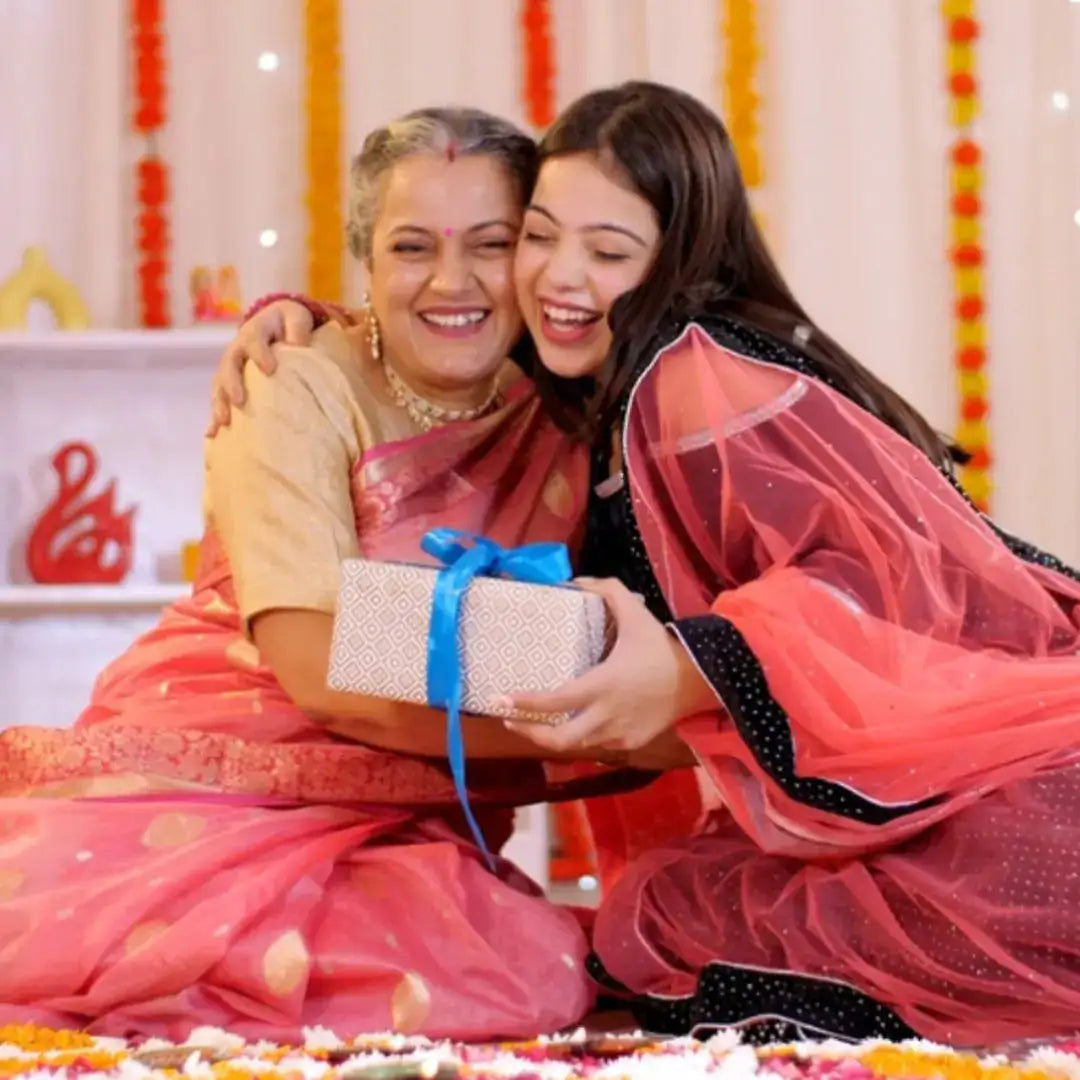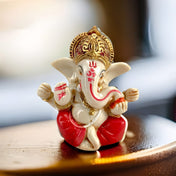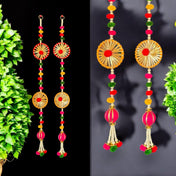Introduction
The Half Saree Ceremony is a cherished traditional Indian ceremony that marks a young girl's transition to womanhood. This significant rite of passage, deeply rooted in South Indian culture, celebrates a girl's first menstruation. Known as the Ritu Kala Samskara in Hindu traditions, this ceremony symbolizes the blossoming of a girl into adulthood.
Significance in South Indian Culture
In South India, the half saree function holds immense cultural importance. It is not just a familial event but a community celebration where relatives and friends gather to honor this pivotal moment in a girl's life. The ceremony serves as an acknowledgment of her new status and responsibilities within the family and society.
Celebrating First Menstruation
The celebration of a girl's first menstruation through the half saree ceremony underscores the cultural significance attached to this biological milestone. It is seen as a time for joy and blessings, with rituals designed to bestow good fortune and health upon the young girl. This tradition plays a crucial role in reinforcing cultural values and familial bonds.
For more inspiration on how to celebrate this milestone with elegance, you can explore our collection of half saree function decorations. It offers various options to create an unforgettable and visually stunning celebration.
Understanding Half Saree Ceremonies
Ritu Kala Samskara: A Rite of Passage
Ritu Kala Samskara, an ancient Hindu rite of passage, marks the transition of young girls into womanhood. This ceremony, deeply rooted in South Indian culture, celebrates a girl's first menstruation, symbolizing her readiness for adulthood and societal roles. The event is not just a personal milestone but also a communal celebration, highlighting the girl's new status within her family and community.
In Hinduism, rites of passage are pivotal in guiding individuals through life's stages. Ritu Kala Samskara is one such ceremony that underscores the importance of female fertility and reproductive health. It honors the onset of menstruation (referred to as Ritushuddhi) as a sacred and transformative event.
Ritushuddhi: A Critical Milestone
Ritushuddhi, translating to "purity through menstruation," is considered a critical milestone for young girls in South India. This concept is intertwined with notions of purity, fertility, and femininity. The half saree ceremony associated with Ritushuddhi serves multiple purposes:
- Affirmation of Womanhood: Celebrates the girl's entry into womanhood.
- Cultural Education: Imparts knowledge about menstrual health and hygiene.
- Community Integration: Reinforces her role within the cultural and social framework.
Through elaborate rituals, prayers, and blessings, the girl is welcomed into this new phase with dignity and respect.
Historical Context: Evolution of Half Saree Ceremonies
The tradition of half saree ceremonies has evolved over centuries but retains its core essence. Originally part of Vedic rituals, these ceremonies have adapted to regional variations across South India. Historically, these functions were grand affairs involving extended families and communities.
In Tamil Nadu, Karnataka, Andhra Pradesh, and Telangana, the half saree ceremony has been preserved meticulously. While modern influences have shaped certain aspects, the essence remains rooted in age-old customs. These ceremonies reflect a blend of historical significance and contemporary adaptations.
Influences from South Indian Wedding Traditions
Half saree ceremonies borrow elements from South Indian wedding traditions:
- Sacred Fire Rituals: Invoking blessings through sacred fire.
- Traditional Music and Dance: Incorporating classical music and dance forms like Bharatanatyam.
- Elaborate Feasts: Serving traditional dishes as part of celebratory feasts.
The richness of Tamil Hindu customs further enriches these ceremonies. Detailed rituals such as applying turmeric (a symbol of purity) and tying protective threads reflect deep cultural meanings.
Influence of Tamil Hindu Customs on Half Saree Ceremonies:
These ceremonies are deeply rooted in Tamil Hindu customs, which add a distinctive charm and significance. The ritual of applying turmeric, for example, is believed to purify the girl's body and soul, preparing her for a new phase of life. The tying of protective threads around her waist symbolizes blessings and safeguards her well-being. These rituals not only connect the girl with her cultural heritage but also signify the importance of purity, protection, and blessings in her journey ahead.
Tamil Nadu's rich cultural tapestry significantly influences half saree ceremonies. These customs are characterized by intricate details:
Decorative Elements:
- Elaborate Floral decorations, vibrant If you're looking for a rangoli mat to create beautiful designs, we have a wide range of options available. patterns, and auspicious symbols like the om or swastika are used to adorn the venue.
- Traditional Attire: The girl wears a half saree, typically in vibrant colors with intricate zari or embroidery work, symbolizing grace and beauty.
- Exchange of Gifts: Guests present the girl with traditional gifts like gold jewelry, silk sarees, and other auspicious items, symbolizing their blessings and support.
- Religious Rituals: Priests conduct puja ceremonies, invoking the blessings of deities and seeking their guidance for the girl's future.
- The seamless blend of Tamil Hindu customs with the joyous celebration of a girl's transition into womanhood makes half saree ceremonies a truly unique and meaningful experience.
- Return Gifts and Favors : To express gratitude to the guests for their presence and blessings, return gifts or favors are given at the end of the ceremony. These could include items like small idols, traditional accessories, or even personalized souvenirs that serve as a token of remembrance for this special occasion.
Key Rituals and Traditions
Thirandukuli: A Celebratory Bath
One of the most significant rituals in a half saree ceremony is Thirandukuli, which symbolizes the girl's transition from childhood to womanhood. This ritual involves a ceremonial bath, often in turmeric-infused water, which is believed to have purifying properties. Turmeric, known for its antiseptic qualities, is a vital element in Hindu rituals. The girl is adorned with flowers and given new clothes, usually a half saree or pavadai (long skirt) and blouse. Surrounding her are women from the family who sing traditional songs, adding a melodious ambiance to the event. This bath marks her readiness to embrace the responsibilities and privileges of womanhood.
Thaalapoli: Welcoming with Auspicious Elements
Another integral part of the ceremony is Thaalapoli, where the young girl is welcomed with an array of auspicious items like rice, turmeric, and flowers arranged on a brass or silver platter. She walks on a path strewn with flower petals while the ladies in the family perform aarti, circling a lit lamp around her face and offering prayers for her well-being and prosperity. This ritual signifies her acceptance into adulthood and the community's acknowledgment of her new status.
Astamangalyam Platter: A Symbol of Prosperity
Central to many South Indian celebrations is the Astamangalyam platter, an assortment of eight sacred items that represent prosperity and auspiciousness. Typically, this platter includes:
- Turmeric: Symbolizes purity and fertility.
- Kumkum: Represents marital status and feminine energy.
- Rice: Signifies abundance.
- Betel Leaves and Areca Nuts: Denote hospitality.
- Coconut: Represents completeness and selflessness.
- Lamps: Signify light and knowledge.
- Flowers: Stand for beauty and freshness.
- Mirror: Reflects clarity and truth.
During the half saree ceremony, this platter plays a crucial role in blessing the young girl as she steps into womanhood. Each item on the platter has its own significance, contributing to her prosperous future. The elders use these items in various blessings throughout the ceremony, ensuring that every aspect of her life is touched by these symbols of good fortune.
Community Participation: Strengthening Bonds
The involvement of extended family, friends, and community members adds another layer of importance to these rituals. Their participation not only reinforces social ties but also ensures that cultural traditions are passed down through generations. By actively engaging in rituals like Thirandukuli and Thaalapoli, everyone present reaffirms their commitment to preserving these age-old customs.
Ceremonial activities such as these are more than just rites;
Outfit Ideas and Saree Draping Styles for Half Saree Ceremonies
Finding the perfect outfit for a half saree ceremony can be both exciting and daunting. This significant event calls for attire that is not only beautiful but also culturally meaningful.
Suggestions for Selecting Outfits
1. Silk Dresses
- Kanjeevaram Silk: Known for its rich texture and vibrant colors, Kanjeevaram silk sarees are a favorite choice. They often feature intricate designs and motifs, making them ideal for a grand occasion.
- Banarasi Silk: With its luxurious feel and elegant patterns, Banarasi silk offers a sophisticated look. These sarees often come with zari work that adds a touch of opulence.
- Mysore Silk: Simpler yet equally stunning, Mysore silk sarees are lightweight and comfortable, perfect for young girls experiencing their first traditional ceremony.
2. Bridal Sarees
Bridal sarees adorned with heavy embellishments, sequins, and embroidery can add an extra layer of elegance to the ceremony. Opting for shades like red, maroon, or gold can make the young girl stand out as she steps into this new phase of life.
3. Contemporary Blends
Modern interpretations of traditional sarees, such as those combining silk with chiffon or georgette, offer a unique twist while maintaining cultural authenticity. These blends provide comfort without sacrificing style.
Overview of Traditional Saree Draping Styles
1. Nivi Style
The most common draping style, the Nivi style involves tucking the saree into the waistband of the petticoat and wrapping it around the waist before draping it over the shoulder. This style is versatile and highlights the saree's intricate designs.
2. Madisar Style
Traditionally worn by Tamil Brahmin women, this style involves wrapping the saree in a way that creates a dhoti-like effect at the bottom. It is both elegant and distinctive, often chosen for its cultural significance.
3. Bengali Style
Characterized by pleats at the front that are tucked into the waistband and an end piece that is draped over both shoulders. This style brings out the beauty of pallu designs and is known for its gracefulness.
4. Maharashtrian Style
Similar to Madisar but with regional variations, this style includes tucking one end of the saree at the back to give it a more structured look. It's often paired with traditional jewelry to enhance its appeal.
5. Gujarati Style
Involves draping the pallu over the right shoulder instead of the left, which allows more visibility of intricate pallu designs in front rather than at the back.
Accessorizing to Enhance
- Jewelry: Traditional gold jewelry including bangles, necklaces, earrings, and hair accessories like jadai (hair braid ornament) complement these outfits beautifully.
- Flowers: Fresh jasmine flowers strung into garlands are often used to adorn hair, adding a fragrant touch to the overall look.
Incorporating these outfit ideas and draping styles ensures that each half saree ceremony becomes a memorable celebration while respecting cultural rituals and traditions.
Preserving Tradition in the Modern Age
The Role of Ayurveda and Special Diets in Preparing for the Ceremony
Ayurveda, an ancient system of medicine, plays a crucial role in South Indian traditions. Especially during significant rites like the half saree ceremony, Ayurveda offers guidelines to ensure the girl’s health and well-being. Special diets rich in nutrients are often recommended to help her transition smoothly into womanhood.
Ayurvedic Practices
- Massages with herbal oils and concoctions tailored to balance her doshas (body energies)
- These practices enhance both physical health and mental relaxation
Nutritious Diets
- The dietary regimen emphasizes foods that boost immunity and strength
- Common ingredients include ghee, milk, almonds, and specific herbs
- These elements are believed to fortify the body and mind, preparing the young girl for her new phase of life
Amazing traditions of India
India is known for its rich cultural heritage with countless amazing traditions. Incorporating these unique customs into half saree ceremonies can make them even more memorable while still preserving tradition.
Personalized Rituals
Including family heirlooms or handmade gifts can add sentimental value. For instance:
- Gifting a saree that has been passed down through generations
- Incorporating traditional jewelry pieces that have historical significance within the family
Decor and Ambiance
Use traditional decor elements such as rangoli designs at the entrance, fresh flower garlands, and diyas (oil lamps). Adding modern twists like themed photo booths or personalized decorations can create lasting memories.
Cultural Performances
Integrate cultural performances such as classical dance recitals (Bharatanatyam or Kuchipudi) or music performances involving traditional instruments like the veena or mridangam. These can make the event more vibrant and culturally rich.
Interactive Activities
Encourage guests to participate in activities linked to Indian culture, such as henna application or learning basic steps of a traditional dance form. This fosters a deeper connection with cultural heritage among younger attendees.
Embracing these aspects ensures that while families honor age-old traditions, they also create an inclusive space where modernity meets heritage. This harmonious blend allows for a richer celebration of girlhood and marks the transition with grace and joy.
Passing Down the Legacy
Preserving these traditions for future generations is incredibly important. The half saree ceremony is a beautiful combination of culture and family love, and it plays a crucial role in the diverse range of South Indian customs. It's not just a significant moment in a young girl's life; it also acts as a way for her to connect with her ancestors.
Having open conversations about cultural heritage within families can help younger members develop a deeper understanding and respect for their roots. By sharing stories about past ceremonies and explaining their significance, we can generate curiosity and pride in our heritage.
Here are some ways to educate younger family members about their roots:
- Storytelling Sessions: Regularly share stories from our family history that highlight the importance of traditions like the half saree ceremony.
- Cultural Activities: Involve children in traditional activities, such as learning how to wear a saree or cooking special dishes for ceremonies, to give them hands-on experiences.
- Interactive Lessons: Make use of multimedia resources like documentaries and books to make learning about cultural heritage more engaging.
- Celebration Participation: Encourage active involvement in organizing and carrying out ceremonies to develop a sense of responsibility and connection.
- Community Involvement: Become part of community groups that honor and protect cultural practices to create a supportive network for passing down traditions.
By blending old customs with modern life, we ensure that these ceremonies stay alive and meaningful for future generations.
Conclusion
The half saree ceremony holds a special place in our culture as it connects the past and present. This important milestone celebrates a young girl's journey into womanhood, marked by meaningful rituals and symbols.
- Preserving Tradition: The half saree ceremony showcases customs that have been passed down for generations. From the unique draping styles to the use of specific ceremonial items, each element holds significant value. Families take pride in preserving these traditions, keeping them alive as an essential part of their cultural heritage.
- Making New Memories: While staying true to its traditional roots, the half saree ceremony also allows for personal touches and contemporary elements. Families can add their own creative ideas such as themed decorations, personalized gifts, or special family rituals to make the occasion even more memorable. These additions not only enhance the celebration but also make it relatable for younger generations.
- Cultural Importance: Through their participation in the half saree ceremony, both young and old members of the community develop a deeper understanding and appreciation for their cultural background. It strengthens their sense of identity and belonging, fostering stronger bonds and shared values within the community.
By blending ancient customs with modern influences, families can honor their heritage while making the ceremony relevant for today's generation. This beautiful blend ensures that traditions like the half saree ceremony continue to thrive and hold a special place in the hearts of those who take part in them.





















1 comment
The blog post on LoveNspire beautifully captures the essence of the Half Saree Ceremony, highlighting its cultural significance and the joyous transition it symbolizes.